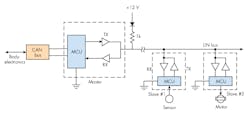The LIN Interface and Automotive Interconnects—A Perfect Match
Download this article in PDF format.
As more electronic subsystems populated automobiles over the years, engineers discovered the necessity of interconnecting them with serial data networks to minimize wiring and optimize their performance. Today, the modern vehicle contains multiple networks, combining some mix of the Controller Area Network (CAN), Media Oriented Systems Transport (MOST), FlexRay, and even Ethernet. But probably the most widely used interface is the Local Interconnect Network (LIN), which connects a variety of sensors and actuators. LIN is a simple 1-wire bus that’s flexible, tolerant, and low cost. Here’s a look at how LIN is used in vehicles today.
Sponsored Resources:
LIN Applications
Most newer vehicles contain at least a dozen LIN nodes. They’re used in applications where data speed isn’t high and many operations are of the off-on type. Common applications include:
- Power door locks
- Power windows
- Power seats
- Power mirrors
- Windshield wipers
- Seat heaters
- Heating and air-conditioning controls
- Interior lights
- Climate controls
- Steering-wheel controls
- Sun roof
- Trunk
If you want to take a look inside one of today’s car models and see where LIN transceivers might be used, check out this blog from Texas Instruments. Within it, an in-cabin virtual view launches and lets you explore a few of the functions that LIN enables today.
LIN 101
LIN is a single-wire bus that uses the vehicle ground as the return. It was created back in the late 1990s and is sponsored by the LIN Consortium. It’s been standardized as ISO17897 and ISO9141. The standard has been revised and updated several times over its lifetime. The LIN standard defines the physical (PHY) and media-access-control (MAC) layers of the OSI networking model.
A LIN bus can accommodate up to 16 drops or nodes. Figure 1 shows the basic arrangement. The master MCU connects to the LIN bus via an external pull-up resistor and protective diode. Slave nodes may be switches or other sensors for inputs and some controlled device or actuator like a motor, relay, solenoid, or LED. These nodes are usually operated by a dedicated MCU and connected by internal pull-up resistors to the bus. The slave nodes on the bus get their directions from a master microcontroller.
1. The diagram represents a simplified version of the LIN bus.
In most vehicles, LIN buses are operated as sub-networks to a CAN bus such as the body electronics bus. Note the connection to CAN in Fig. 1.
The LIN transceivers at each node usually operate from the main 12-V vehicle electrical system. Logic levels are typically 0 V and +12 V. The upper data rate is usually 20 kb/s at the maximum bus range of 40 meters. It has the potential to support rates up to 100 kb/s over shorter distances. Data coding is non-return to zero (NRZ).
The LIN protocol frame is illustrated in Figure 2. The LIN transceivers use the familiar UART format with 8 bits of data plus start and stop bits. The master node communicates with each node by sending a break field of 13 bits to establish synchronization between master and slave. No precision crystal clock is required. A 10-bit identifier (6 address, 2 parity, start-stop) is used to select the desired node. The addressed slave then responds with 0 to 8 bytes of data, followed by a 10-bit checksum.
2. For LIN standard protocol frames, each byte of data has a stop and start bit, making 10 bits per character.
In summary, the LIN bus is attractive because it uses a simple 1-wire bus; it operates with the basic automotive battery supply; data synchronizes without a crystal reference; and no license fee is required unlike with CAN and other networks.
A Typical Automotive LIN Transceiver
LIN transceivers are available in various configurations from multiple manufacturers. A representative device is Texas Instruments’ TLIN1029-Q1. It can operate from a supply voltage in the 4- to 36-V range. It’s heavily protected from electrostatic discharge (ESD), transients, and thermal overload. A data rate up to 20 kb/s is possible. It has a sleep mode to conserve power and a wakeup feature to signal a transmission. The transceiver, which operates over the temperature range of −40 to +125°C, comes in multiple package types.
When choosing a LIN transceiver for 24-V vehicles like trucks, forklifts, or buses, it’s vital to ensure it’s well protected from transients. The power bus in the vehicle experiences a wide variety of transients that include a ~50% drop in voltage during starting, a 120-V load dump spike that can occur if the battery is disconnected from the alternator, induced noise pulses, and reverse polarity potential.
The LIN bus is simple, reliable, rugged, and inexpensive. It’s proven itself over and over again in modern automobiles. And, of course, the versatile standard and protocol can be used in other industrial or consumer applications. Get to know it.
Sponsored Resources:



